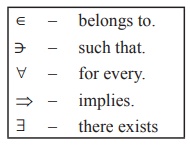Mathematics - Discrete Mathematics | 12th Maths : UNIT 12 : Discrete Mathematics
Chapter: 12th Maths : UNIT 12 : Discrete Mathematics
Discrete Mathematics
Discrete Mathematics
"Young man, in mathematics you don’t understand things.
You just get used to them". -John von Neumann
Introduction
Mathematics can be broadly classified into two categories: Continuous
Mathematics − It is based upon the results concerning the set of real
numbers
which is uncountably infinite. It is characterized by the fact that between any two real
numbers, there is always a set of uncountably infinite numbers. For example, a
function in continuous mathematics can be plotted in a smooth curve without
break.

Discrete Mathematics − It involves distinct values which are either finite or countably infinite; i.e. between any two points, there are finite or countably infinite number of points. For example, if we have a finite set of objects, the function can be defined as a list of ordered pairs having these objects, and can be presented as a complete list of those pairs.
The mathematicians who lived in the latter part of the 19th and
early in the 20th centuries developed a new branch of mathematics called discrete
mathematics consisting of concepts based on either finite
or countably
infinite sets like the set of natural numbers. These sets are called
discrete sets and the beauty of such sets is that, one can find that a
one-to-one correspondence can be defined from these sets onto the set of
natural numbers. So, the elements of a discrete set can be arranged as a
sequence. This special feature of discrete sets cannot be found in any
uncountable set like the set of real numbers where the elements are distributed
continuously throughout without any gap.
Everyone is aware of the fact that the application of
computers is playing an important role in every walk of our lives. Consequently
the computer
science has become partially a science of clear understanding and
concise description of computable discrete sets. Also the modern programming
languages are to be designed in such a way that they are suitable for
descriptions in a concise manner. This compels the computer scientists to train
themselves in learning to formulate algorithms based on the discrete sets.
The main advantage of studying discrete mathematics is that
its results serve as very good tools for improving the reasoning and problems
solving capabilities. Some of the branches of discrete mathematics are combinatorics,
mathematical logic, boolean algebra, graph theory, coding theory etc. Some of the topics of discrete mathematics namely permutations,
combinations, and mathematical induction were
already discussed in the previous year. In the present chapter, two topics namely binary operations
and mathematical
logic of discrete mathematics are
discussed.
Symbols

In general, the word ‘operation’ refers to the process of
operating upon either a single or more number of elements at a time. For
instance, finding the negative of an element in ℤ involves a single element at a time. So it is called an unary operation.
On the other hand the process of finding the sum of any two elements in ℤ involves two elements at a time. This kind of operation is called a binary
operation and in general an operation involving n elements is called an n-ary operation, n ∈ ℕ. In this section a detailed discussion of the binary operations is
presented.
Learning Objectives
Upon
completion of this chapter, students will be able to
• define
binary operation and examine various properties
• define
binary operation on Boolean matrices and verify various properties
• define
binary operation on modular classes and examine various properties
• identify
simple and compound statements
• define
logical connectives and construct truth tables
• identify
tautology, contradiction, and contingency
• establish logical equivalence and apply duality principle
Related Topics